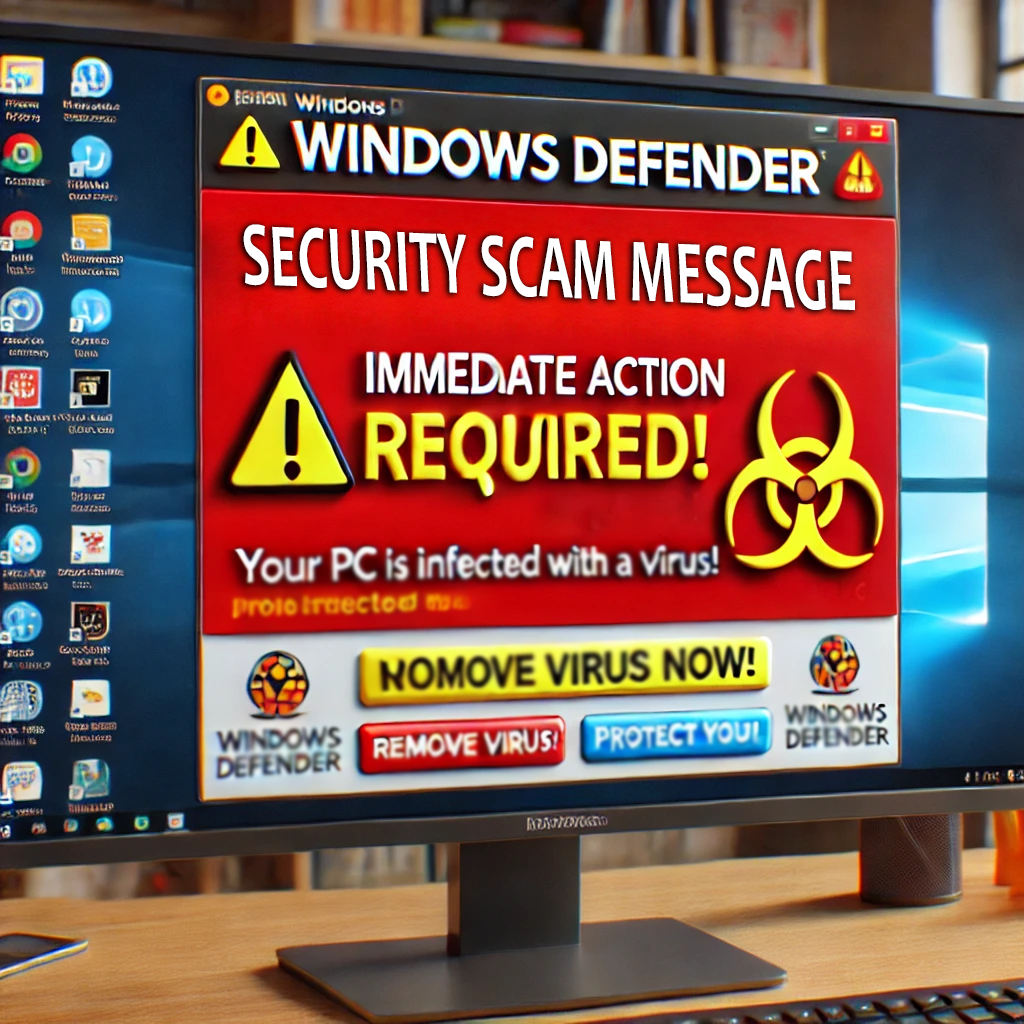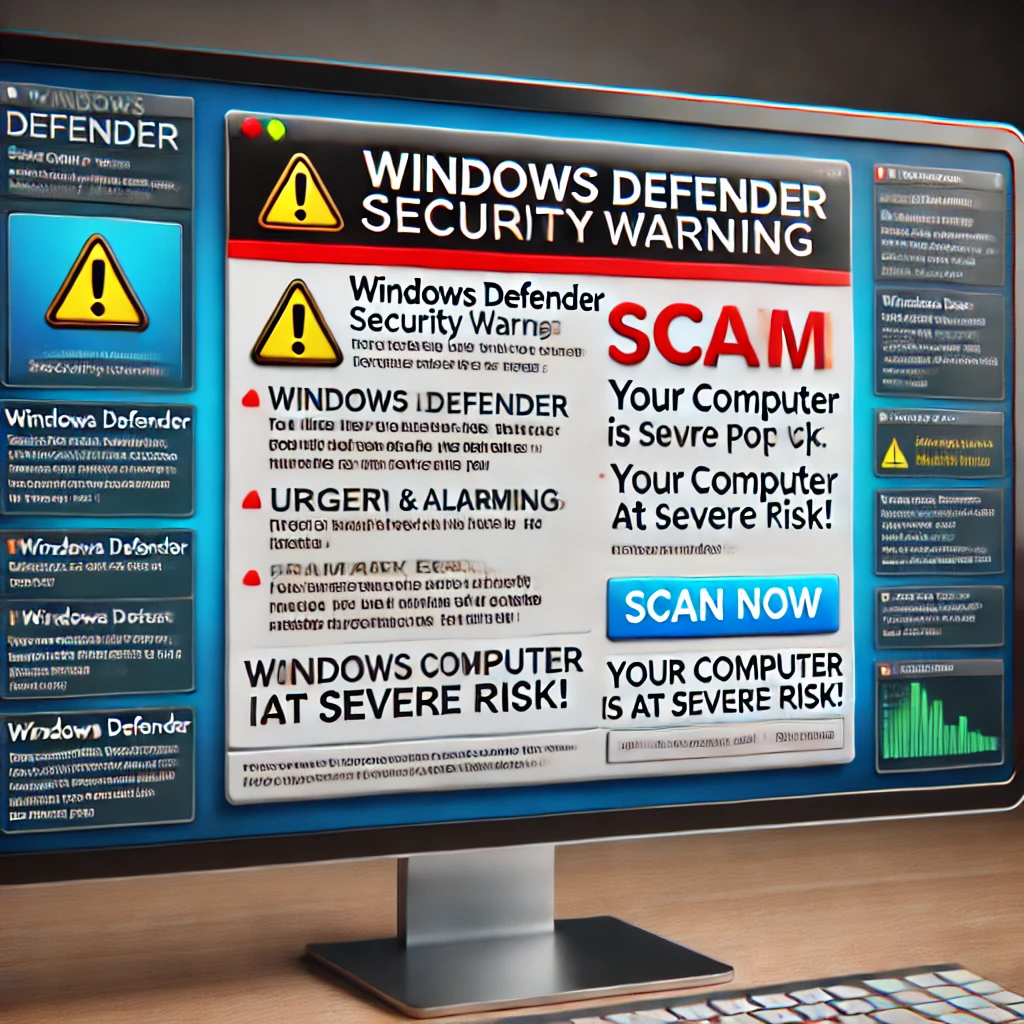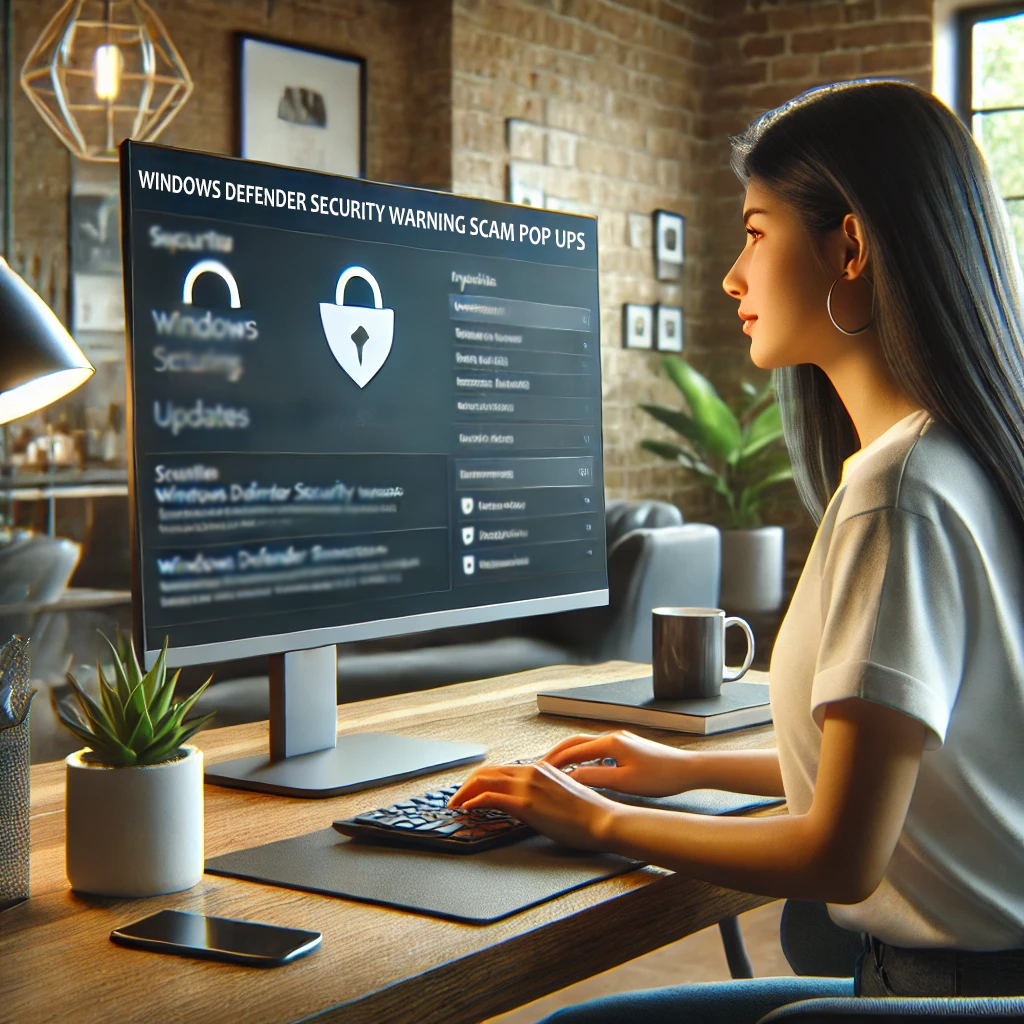Windows Defender Security Scam Message
In recent years, the digital landscape has become a battleground for cybersecurity, with malicious actors continuously evolving their tactics. Among the plethora of security threats, the Windows Defender scam pop up has emerged as a particularly insidious deception. These fake Windows Defender security warnings are designed to mimic legitimate security alerts from Microsoft’s built-in antivirus program, exploiting the trust of unsuspecting users.
The Windows Defender security scam often presents itself through alarming pop-ups that claim your computer is at risk or already infected. Such pop-ups aim to create a sense of urgency, tricking users into taking immediate action, which can include providing personal information, downloading harmful software, or directly paying for bogus services. Recognizing these Windows Defender alerts as fraudulent is crucial not only for protecting personal information but also for maintaining the integrity of your system.
The significance of identifying and responding appropriately to these Windows security alerts cannot be overstated. With the correct knowledge and vigilance, users can effectively avoid the pitfalls of these sophisticated scams. Therefore, this article aims to empower you by detailing how to spot a Windows Defender security warning pop up that’s a scam, understand the mechanics behind these deceitful alerts, and take decisive actions to protect yourself and your digital environment.
Through a detailed exploration of common signs, preventative measures, and recovery steps, this blog will equip you with the tools necessary to safeguard your digital well-being against the ever-present threat of fake Windows Defender security warnings and other related scams. Let’s dive into the essentials of protecting yourself from these deceptive tactics that threaten our online peace of mind.
Understanding Windows Defender Security Scam Pop Ups
Windows Defender scam pop ups are a type of online fraud designed to trick users by masking as legitimate security notifications from Microsoft’s Windows Defender. These fraudulent pop-ups are cunningly crafted to look and feel like genuine Windows Defender alerts, often causing immediate concern among users who fear their system’s security has been compromised.
Common characteristics of Fake Windows Security Alerts
These deceptive alerts typically manifest in several ways, but they share common characteristics that you can learn to identify. Some of them are:
- The first telltale sign of a bogus Windows security alert is the urgent and alarmist language used to create a sense of panic. Phrases such as “Immediate action required!” or “Your PC is infected with a virus!” are common and are created to provoke an emotional response that can lead users to act hastily and against their best interests.
- Another common feature of these scams is the request for personal information or financial details. A legitimate Microsoft Windows Defender alert would never ask for your personal credentials directly through a pop-up. Additionally, these scam alerts might prompt users to download software or pay for fake antivirus services directly through the pop-up, actions that genuine software would never initiate.
- The fake Windows Defender security warning may also include buttons or links asking you to ‘Confirm’ or ‘Clean your PC now’, which when clicked, could lead to downloading malware or potentially unwanted programs (PUPs). The goal of the Windows Defender security scam message is often to install malicious software that can steal data, damage your files, or gain control of your computer.
Understanding that real security messages from Windows will never include requests for immediate payments or sensitive personal information can help you distinguish the Windows Defender scam pop up from legitimate alerts. Always approach unexpected security warnings with skepticism and verify their authenticity before taking any action suggested by the pop-up.
Recognizing these fraudulent tactics is your first line of defense against the Windows Defender security warning scam pop up. By familiarizing yourself with the nuances of these fraudulent alerts, you can better protect yourself from the threats they pose.
How Windows Security Alert Scams Work?
Understanding how Windows Defender security scams operate is key to securing yourself from falling victim to them. These scams typically initiate when a user inadvertently triggers them by visiting suspicious websites or inadvertently downloading malware that alters the system’s behavior to display fraudulent alerts.
- The process begins with a Windows security alert pop up appearing unexpectedly on your screen. These pop-ups are designed to look convincingly like a real Windows Defender security warning, making them particularly deceptive. The scammers meticulously craft these alerts to create a facade of legitimacy and urgency.
- Typically, the fake Windows Defender security warning is generated by adware or less harmful malware already present on the computer. This malware is often unwittingly installed by the user when they download free software from unverified sources, open infected email attachments, or browse compromised websites. Once active, the malware manipulates the system to display these fake Windows security alerts.
- The primary aim of these alerts is twofold: firstly, to steal personal information, and secondly, to install more malicious software. The Windows Defender scam pop up may ask you to enter sensitive information, such as your login credentials or credit card numbers, ostensibly to verify your identity or to purchase additional protection. This directly leads to identity theft or financial fraud.
- Alternatively, the pop-up might encourage you to download what it claims is necessary security software to remove detected threats. This so-called security software is actually malware, and installing it can lead to severe problems, such as a Windows Defender Trojan alert, where your system becomes host to a Trojan horse that could gather data, spy on your activities, or provide a backdoor to other malicious entities.
- Moreover, these scams can also involve a fake Windows Defender alert convincing users to allow remote access to their computers. Under the guise of tech support, scammers can gain control over your system, furthering their ability to extract personal data or deploy additional malware.
Each of these actions—from the moment the fake Windows security alert appears to the potential installation of additional malware—forms a calculated strategy to exploit, damage, and profit from unsuspecting users. Being aware of these tactics, and the typical appearance and behavior of these scam pop-ups, such as the Windows Defender security warning pop up, is crucial in maintaining not just your system’s health but also your personal and financial security.
Common Signs of a Windows Defender Security Warning Scam Pop Up
Being able to recognize a fake Windows security alert is essential in safeguarding your digital information and devices. These scam pop-ups often mimic the appearance of legitimate Windows Defender security alerts but typically exhibit a number of warning indications that can alert an attentive user to their deceitful nature. Here are some key indicators that can help you identify a Windows Defender scam pop up:
-
Poor Grammar and Misspellings:
Legitimate alerts from Microsoft are professionally written and thoroughly checked for grammatical correctness. A fake Windows Defender security warning often contains errors in spelling, punctuation, or syntax. Such mistakes are a clear sign that the alert is not from a reputable source.
-
Urgent and Alarmist Language:
A genuine Windows security warning aims to inform, not to frighten. If a pop-up message is pushing you to act immediately, using phrases like “immediate action required” or “your computer is at serious risk,” it is likely a scam. This tactic is designed to create panic and haste, clouding your judgment.
-
Requests for Personal Information or Payment:
No legitimate Windows Defender alert will ever ask for your personal details or direct payments through a pop-up notification. If the alert requests your financial information, login credentials, or direct payments to resolve an issue, it is definitely a scam.
-
Offers to Download Software:
If a pop-up prompts you to download new security software or updates, be wary. Windows Defender updates itself through the Windows Update feature, not through browser pop-ups. Any pop-up suggesting otherwise is almost certainly a fake Windows Defender alert.
-
Unfamiliar Sender or Source:
The source of a legitimate alert will always be Microsoft or Windows Defender itself, and not an unknown or suspicious entity. Check the branding and credentials on the pop-up. If they seem off or unfamiliar, it’s likely a fake Windows security alert.
-
Pop Up Frequency and Behavior:
Frequent and invasive pop-ups are a common trait of scam operations. Legitimate warnings from Windows Defender will not overwhelm the user with continuous alerts. If you encounter aggressive pop-ups that are difficult to close or that reappear after being closed, they are likely fraudulent.
By familiarizing yourself with these common signs of a Windows Defender security warning scam, you can better protect yourself from falling victim to these deceptive tactics. Always take a moment to critically assess any security alert before taking action, and when in doubt, manually check your security status through the official Windows Security app rather than interacting with a pop-up.
Immediate Steps to Take if You Encounter a Windows Security Alert Scam Pop Up
When faced with a Windows Defender scam pop up, your immediate response can significantly impact the security of your personal information and computer system. Here’s a step-by-step guide on how to handle these situations effectively and check if your system is genuinely at risk.
-
Do Not Interact with the Pop Up:
The first and most crucial step is to avoid interacting with the pop-up. Do not click on any part of the alert, whether it’s the close button, a link, or an OK button. Scammers can design fake Windows Defender security warnings so that any interaction could potentially trigger malware installation.
-
Close the Browser Using Task Manager:
Use the Task Manager to safely close the pop-up window. To open Task Manager, click Ctrl+Shift+Esc, find your browser in the list of running applications, and click ‘End Task’. This method ensures that the browser closes entirely without triggering any scripts that might be running in the pop-up.
-
Perform a System Scan:
After closing the suspicious pop-up, conduct a full system scan using your legitimate antivirus software to check if your system has been compromised. Ensure your antivirus is up-to-date and utilize Windows Defender or any other reputable antivirus program to search for any traces of malware or suspicious activity.
-
Clear Your Browser Cache:
Clearing your browser cache can remove any remaining elements of the scam pop-up. This step is crucial as it prevents the scam from persisting in your browser sessions. Each browser has a slightly different process for clearing the cache, so refer to the specific instructions for the browser you use.
-
Update Your Software:
Make sure your operating system and all installed software are up-to-date. Updates frequently include security patches that protect against new types of exploits and malware, including those that might be used by fake Windows security alert pop ups.
-
Educate Yourself About Recent Scams:
Stay informed about the latest security threats, including common characteristics of fake Windows Defender alerts. Knowledge is an effective tool in recognizing and avoiding future attacks.
-
Report the Incident:
If possible, report the fake Windows Defender security scam message to the relevant authorities or cybersecurity watchdogs. Sharing information about your experience can help others avoid similar scams.
By following these immediate steps, you can minimize the risk posed by Windows Defender scam pop ups and maintain the security of your digital environment. Always be cautious and act swiftly when you suspect a scam to protect yourself from potential harm.
Protecting Yourself from Future Windows Defender Security Warning Scam Pop ups
To fortify your defenses against future Windows Defender scam pop ups and other cyber threats, it’s crucial to adopt a comprehensive approach to computer security. Here are practical steps you can take to enhance your system’s protection and ensure you are well-prepared to handle any Windows security alerts.
-
Regular Updates:
Ensure your operating system and all software applications are regularly updated. Updates often contain critical patches that fix vulnerabilities which could be exploited by scammers. For Windows users, enable automatic updates to ensure you receive the latest security improvements without delay, helping to mitigate risks such as a Windows Defender security warning on Windows 10.
-
Use Reputable Antivirus Software:
Install and maintain a reputable antivirus program. Programs like Windows Defender Security Center provide real-time protection against threats, scanning downloads and updates for malware before they can cause harm. Set your antivirus to update automatically to keep its malware definitions current and make it more effective against new threats represented by fake Windows Defender security warnings.
-
Enhanced Security Settings:
Adjust your browser and security software settings to enhance protection. Enable features like pop-up blockers and phishing filters to decrease the risk of encountering malicious software. These settings can help prevent Windows Defender scam pop ups and other intrusive attempts to compromise your system.
-
Backup Your Data:
Regularly back up your data to an external drive or a cloud storage service. This step ensures that in the event of a security breach, you can recover your important files without significant loss. Data backups are a critical defense against ransomware attacks that might be disguised as Microsoft Defender security warnings.
-
Education and Awareness:
Stay informed about the most recent cybersecurity attacks and learn how to recognize signs of scams. Educational resources such as blogs, cybersecurity newsletters, and official updates from software providers can enhance your ability to discern between legitimate and fake Windows Defender security warnings.
-
Use Strong, Unique Passwords:
Employ strong, unique passwords for different accounts to reduce the risk of multiple accounts being compromised if one password is stolen. Consider using a password manager to keep track of your passwords securely.
-
Network Security:
Secure your home and office networks. Use a strong Wi-Fi password, and consider using a VPN, especially when linked to public networks. This helps protect against cyber threats that might try to intercept sensitive information.
-
Regular Security Audits:
Periodically review your security practices and system settings to ensure they are optimal. This includes checking the permissions of the software and applications you have installed and ensuring there are no unknown applications that might pose a Windows Defender security center alert.
By taking these proactive steps, you can significantly bolster your defenses against Windows Defender scam pop ups and other malicious attempts to compromise your digital security. Awareness, preparedness, and the right tools are your best supporters in maintaining a safe and secure online environment.
What to Do if You Fall Victim to a Windows Security Scam Pop up
If you realize that you have fallen victim to a Windows Defender scam pop up or any related fake Windows security alert, taking swift and decisive action is crucial to mitigating potential damage. Here’s what you should do if you suspect your personal information has been compromised:
-
Disconnect from the Internet:
Immediately disconnect your computer from the internet. This prevents any ongoing data transmission to scammers and can help mitigate further data loss or malware spread.
-
Change Your Passwords:
Make sure you update the passwords on all of your internet accounts, particularly those linked to social media, email, and banking. If the scam involved a fake Windows Defender security warning that may have captured your keystrokes, assume that all login credentials entered during the session could be compromised. Use another, secure device to change your passwords.
-
Alert Your Financial Institutions:
Contact your banks and credit card companies to alert them to the potential breach. Request to freeze your accounts or set up additional monitoring for suspicious activities. This is a critical step if any financial information was exposed during the Windows Defender security scam.
-
Run a Security Scan:
Use legitimate antivirus software to run a thorough scan of your system. This helps to locate and remove any malware that may have been installed. Ensure your antivirus definitions are up-to-date before running the scan.
-
Report the Scam:
Report the incident to the appropriate authorities. This could include national fraud reporting websites, local law enforcement, and any specific internet crime agencies in your country. Reporting helps authorities track scam patterns and potentially warn others about the Windows Defender scam pop up.
-
Monitor Your Accounts:
Keep a close watch on your financial statements and credit report for signs of unauthorized activity. Some institutions offer services to alert you to suspicious transactions, which can be invaluable after exposure to a fake Microsoft Windows Defender security warning pop up.
-
Restore Your System:
If necessary, restore your system to a state before the compromise if you have a system backup available. This can help ensure that any remnants of the scam or malware are completely removed from your system.
By applying these steps, you can effectively respond to and recover from falling victim to a Windows Defender scam pop up or any similar Microsoft Windows Defender alert. Quick and thoughtful action can significantly reduce the impact of the scam on your personal and financial well-being.
FAQs
Q1. What is a Windows Defender scam pop up?
- A. A Windows Defender scam pop up is a fraudulent alert that mimics legitimate Windows security alerts. These scams trick users into believing their system is at risk to steal personal information or install malware.
Q2. How can I identify a fake Windows Defender security warning?
- A. You can identify a fake Windows Defender security warning by looking for poor grammar, urgent language, requests for personal information, or prompts to download software, which are not characteristics of legitimate Microsoft Windows Defender alerts.
Q3. What should I do if I encounter a Windows Defender pop up scam?
- A. If you encounter a Windows Defender pop up scam, do not click on any links or buttons. Instead, close your browser using Task Manager and run a full system scan with a reputable antivirus software to ensure no malware was installed.
Q4. How do Windows Defender security scams typically operate?
- A. Windows Defender security scams typically operate by triggering a windows security alert pop up through adware or malware already on your computer, convincing users to act immediately by providing personal data or making payments.
Q5. What are the risks of clicking on a bogus Windows security alert?
- A. Clicking on a bogus Windows security alert can lead to malware installations, financial loss from fraudulent charges, or unauthorized access to your personal and financial information.
Q6. Can a Windows Defender security warning pop up appear legitimate?
- A. Yes, a Windows Defender security warning pop up can appear very legitimate, making it essential to know the signs of a scam, such as unexpected requests or the method of the alert’s delivery.
Q7. How can I prevent falling for a Windows Defender security warning scam?
- A. Prevent falling for a Windows Defender security warning scam by keeping your software up-to-date, using reputable antivirus programs, and educating yourself about the latest cybersecurity threats.
Q8. What steps should I take if I mistakenly clicked on a fake Windows security alert?
- A. If you clicked on a fake Windows security alert, immediately run a security scan, change all your passwords, alert your financial institutions, and monitor your accounts for unusual activity.
Q9. Why is it important to report a Windows Defender security scam?
- A. Reporting a Windows Defender security scam helps authorities track and mitigate these scams, potentially preventing others from being victimized and helping to develop better protective measures.
Q10. Where can I learn more about securing myself from Microsoft Defender security warnings and other scams?
- A. You can learn more about protecting yourself from Microsoft Defender security warnings and other scams by visiting trusted cybersecurity websites, subscribing to security newsletters, and regularly checking updates from software vendors, including Microsoft.
Conclusion
The threat posed by Windows Defender scam pop ups and similar cybersecurity scams is real and constantly evolving. Throughout this blog, we’ve explored the insidious nature of these scams, from fake Windows Defender security warnings to security alerts that seek to deceive and exploit unsuspecting users. Recognizing these threats is the first step towards safeguarding your digital life.
As we’ve detailed, understanding the signs of a fake Windows Defender security warning and the mechanisms behind such scams is crucial. By educating yourself about these indicators—urgent and alarmist language, requests for personal information, and asks to download software—you can more effectively scrutinize and dismiss fraudulent alerts.
However, awareness alone is not enough. Vigilance is equally important. Cybersecurity is a proactive endeavor that requires ongoing attention and action. Regular updates, the use of reputable antivirus solutions like Microsoft Defender, and general cybersecurity hygiene are essential practices that help mitigate the risk of falling prey to a Windows Defender security scam pop up. To get a proper assistance regarding this issue, you can contact our support number mentioned on our Microsoft Support Page. Our dedicated support team is always there to help you.
Moreover, staying informed about the latest in cybersecurity threats and trends plays a critical role in your defense. Windows security alerts and updates from trusted sources can provide timely information that might prevent a security breach. By fostering a culture of security-mindedness, you can improve not only your own safety but also contribute to the collective security of the online community.
In conclusion, let this blog serve as a reminder and a resource for navigating the complexities of online security threats. Remember, each Windows Defender security warning or Microsoft Defender alert you receive could be genuine or a gateway to a scam. Distinguishing between the two is your key to maintaining a secure and trustworthy digital environment. Remain curious, cautious, and committed to your cybersecurity practices, and you will significantly reduce the likelihood of compromise.

